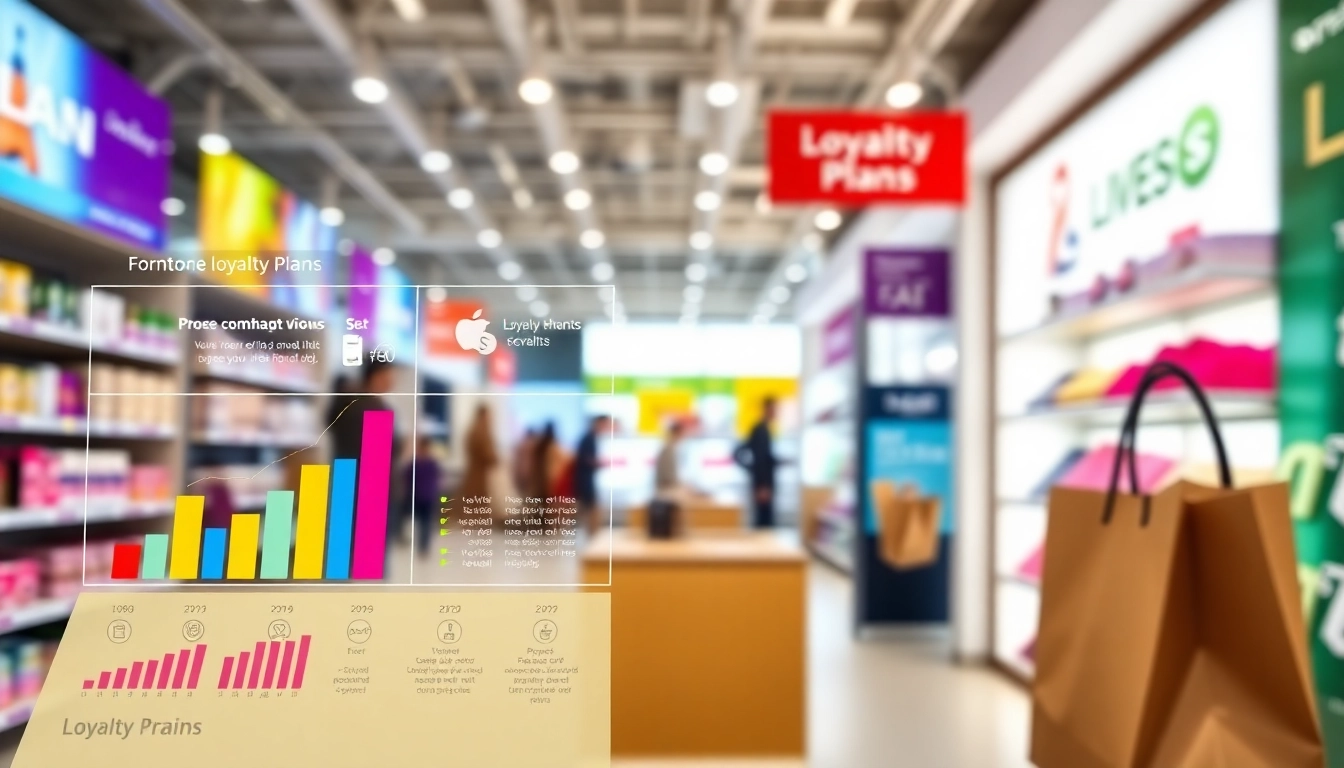Understanding Loyalty Plans
Loyalty plans have become an essential part of modern marketing strategies, enabling businesses to foster stronger relationships with their customers. By encouraging repeat business through rewards, these plans not only help retain existing customers but also attract new ones. The significance of loyalty plans in today’s competitive landscape cannot be understated; they serve as a powerful tool to enhance customer satisfaction and boost overall profitability. For businesses looking to establish or improve their customer retention strategies, understanding how loyalty plans work is critical. This is especially true for organizations aiming to implement data-driven strategies, thus making Loyalty Plans a vital component of their operations.
What are Loyalty Plans?
A loyalty plan, also referred to as a loyalty program, is a structured marketing strategy designed to encourage customers to make repeat purchases. These programs reward customers based on their purchase behavior, often through the accumulation of points that can be redeemed for discounts, free products, or exclusive benefits. The underlying principle is straightforward: the more a customer engages with a brand, the more rewards they can earn. A common characteristic of loyalty programs is that they leverage data analytics to understand customer preferences, thus creating personalized experiences that resonate with individual needs.
Key Benefits of Loyalty Plans
Loyalty plans offer numerous advantages for both businesses and customers, including:
- Increased Customer Retention: Loyalty programs are known to enhance customer lifetime value (CLV) by encouraging repeat visits and purchases. Retained customers are often more profitable than new ones, making their loyalty a critical focus for businesses.
- Enhanced Customer Experience: By providing rewards and personalized incentives, customers feel valued and appreciated. This improves the overall customer experience and increases brand loyalty.
- Actionable Insights: Loyalty programs can gather valuable data on customer behaviors, preferences, and spending patterns. Businesses can analyze this data to tailor their offerings and marketing strategies accordingly.
- Competitive Edge: In crowded markets, having a well-structured loyalty plan can differentiate a brand from its competitors, making it more attractive to customers.
Common Types of Loyalty Plans
Organizations can choose from various types of loyalty plans, each designed to achieve specific objectives. Common types include:
- Points-Based Systems: Customers earn points for each purchase, which can be redeemed for rewards. This is the most common type of loyalty program seen across multiple industries.
- Tiers of Loyalty: Customers progress through different levels of loyalty, receiving enhanced benefits as they move to higher tiers. This encourages ongoing engagement and spending.
- Cashback Programs: Customers receive a percentage of their spending back as cash rewards. This approach directly ties the reward to the customer’s spending.
- Coalition Programs: Businesses partner with other companies to create a unified loyalty program. Customers can earn and redeem points across multiple participating brands, significantly increasing the program’s appeal.
Implementing Effective Loyalty Plans
Creating a successful loyalty program involves strategic planning and execution. Here’s a comprehensive look at how businesses can implement effective loyalty plans.
Steps to Create a Loyalty Program
Establishing a loyalty program requires several crucial steps:
- Define Objectives: Determine what you want your loyalty program to achieve. Objectives may include increasing repeat purchases, enhancing customer engagement, or improving brand perception.
- Identify Customer Segments: Understanding your customer base is crucial. Identify different segments based on spending habits, preferences, and demographic information.
- Choose a Loyalty Model: Decide on the type of loyalty program that best fits your business model and customer behavior. Each model offers unique advantages suited to different objectives.
- Establish Reward Structures: Create a clear and enticing reward structure. The rewards should be valuable enough to motivate customers while remaining financially viable for the business.
- Invest in Technology: Utilize technology platforms that can manage loyalty programs efficiently. This includes tracking purchases, managing customer data, and communicating with program members.
- Promote Your Program: Effectively market your loyalty program to your customers. Use various channels such as email, social media, and in-store promotions to spread awareness.
- Measure Performance: Regularly assess the performance of your loyalty program against established KPIs (Key Performance Indicators) to understand its effectiveness and areas for improvement.
Choosing the Right Technology for Your Loyalty Plans
The technology that supports a loyalty program is crucial for its success. Businesses must consider the following aspects when choosing a technology platform:
- Integration Capabilities: Choose a platform that can seamlessly integrate with existing systems, such as Point of Sale (POS) systems, Customer Relationship Management (CRM) software, and eCommerce platforms.
- User-Friendly Interface: Ensure that both customers and employees find the technology easy to navigate. A complex system can deter customer participation and hinder employee engagement.
- Analytics and Reporting: A robust analytics feature can provide valuable insights into customer behaviors and preferences, allowing businesses to adapt their strategies effectively.
- Scalability: Opt for technology that can scale as your business grows. Flexibility is critical to adapting to changing customer needs and market conditions.
Integrating Loyalty Plans with Marketing Strategies
For loyalty programs to be effective, they must align with the broader marketing strategy of the business. Here are a few ways to integrate loyalty plans effectively:
- Cross-Promotions: Use existing marketing channels to promote the loyalty program alongside current promotions or special events.
- Personalized Communication: Utilize customer data to send targeted offers that resonate with individual customer needs. This shows customers that their loyalty is recognized and appreciated.
- Reward Activation: Run campaigns that encourage customers to redeem their rewards. This not only enhances customer satisfaction but also drives foot traffic or online visits.
Measuring the Success of Loyalty Plans
Measuring the effectiveness of loyalty plans is crucial for understanding their impact on your business. Evaluating performance not only highlights successes but also identifies areas needing improvement. Here’s how businesses can measure their loyalty programs efficiently.
Key Performance Indicators (KPIs)
When assessing a loyalty program’s success, several KPIs should be monitored:
- Customer Retention Rate: Calculate the percentage of customers who continue to engage with the brand over a specific time period.
- Average Order Value (AOV): Measure whether loyalty program participants are spending more than non-participants.
- Redemption Rates: Evaluate how many earned rewards are actually redeemed, which provides insight into the program’s effectiveness and perceived value.
- Customer Feedback and Satisfaction Scores: Collect feedback through surveys or reviews to help gauge customer satisfaction and areas for improvement.
Analyzing Customer Feedback
Customer feedback plays a significant role in refining loyalty programs. Businesses should consider the following strategies for effective feedback analysis:
- Surveys and Polls: Regularly conduct surveys to gather direct feedback on customer experiences and satisfaction with the loyalty program.
- Focus Groups: Organize focus groups to understand customers’ perceptions and expectations of the loyalty program, gaining deeper insights into specific areas for improvement.
- Social Listening: Monitor social media platforms for customer discussions regarding the loyalty program to capture spontaneous feedback.
Adjusting Loyalty Plans Based on Data Insights
Utilizing data insights to adjust loyalty programs is essential for their ongoing success. An iterative approach allows businesses to refine their offerings continually:
- Identify Trends: Use data analysis to identify trends in customer behavior and preferences, adjusting the loyalty offerings to align with these insights.
- Revise Reward Structures: If certain rewards go largely unredeemed, consider re-evaluating these elements or replacing them with more desirable options.
- Test and Iterate: Implement A/B testing strategies to assess changes in the loyalty program, determining what modifications lead to better performance.
Case Studies: Successful Loyalty Plans
Exploring real-world examples of loyalty programs can provide valuable lessons and inspiration for businesses looking to enhance their customer retention strategies. Below are notable case studies and insights on what works and what doesn’t.
Retail Brands with Notable Loyalty Programs
Several retailers have emerged as leaders in loyalty programs, demonstrating successful implementation strategies:
- Starbucks Rewards: Starbucks’ loyalty program allows members to earn stars for every purchase, which can be redeemed for free items. The program’s tiered structure motivates customers to spend more to achieve higher rewards, increasing both average order size and customer retention.
- Sephora Beauty Insider: Sephora’s program offers members points for purchases and tiered benefits including exclusive access to products and events. By personalizing the shopping experience through curated recommendations, Sephora significantly enhances customer loyalty.
- Amazon Prime: Amazon’s subscription model acts as a loyalty program, offering benefits such as free shipping, exclusive content, and discounts. This model keeps customers actively engaged with the brand, leading to high customer retention rates.
Lessons from Failed Loyalty Plans
While many brands succeed with loyalty programs, several have failed. Learning from these failures can provide cautionary tales:
- Gap’s Rewards Program: After failing to deliver meaningful rewards and complicated point redemption, Gap’s loyalty program struggled to engage its customer base, ultimately leading to its discontinuation.
- Payless ShoeSource: Payless introduced a loyalty program without properly researching customer needs, leading to low participation rates and customer dissatisfaction.
Innovative Approaches to Loyalty Plans
Innovative approaches to loyalty programs can differentiate brands and create memorable customer experiences:
- Gamification: Businesses can incorporate game-like elements into loyalty programs, where customers earn rewards through challenges or competitions, making engagement more enjoyable.
- Sustainability Initiatives: Brands like REI have introduced loyalty programs that reward customers for sustainable practices, such as recycling or opting for eco-friendly products, thus aligning with their brand values.
The Future of Loyalty Plans
The landscape of customer loyalty continues to evolve with the integration of new technologies and changing consumer expectations. Understanding emerging trends and adapting accordingly is critical for the longevity of loyalty programs.
Trends Influencing Loyalty Programs
The future of loyalty plans will be shaped by several key trends:
- Personalization: Customers increasingly expect tailored experiences that cater to their individual preferences. Leveraging data analytics for personalized rewards and communication will become a necessity.
- Increased Use of Mobile: As mobile commerce continues to rise, loyalty programs must offer seamless mobile experiences that allow customers to track rewards and redeem them conveniently.
- Social Media Integration: Loyalty programs will become more intertwined with social media platforms, where sharing experiences and connecting with brands can earn customers additional rewards.
The Role of Technology in Loyalty Plans
Technology will play a pivotal role in the advancement of loyalty programs:
- AI and Machine Learning: These technologies can analyze customer data more effectively, helping businesses tailor offerings based on predictive analytics.
- Blockchain for Transparency: Blockchain can offer a transparent and secure way to track loyalty points, reducing fraudulent activities while increasing customer trust.
Preparing for the Evolving Customer Expectations
Businesses must proactively adapt to meet the evolving expectations of loyalty program participants:
- Consumer Education: Ensuring customers fully understand how loyalty programs work and the benefits they offer will improve engagement and satisfaction.
- Feedback Mechanisms: Continuously gather and analyze customer feedback to adjust offerings quickly and address any concerns.
- Agility in Offering Rewards: Flexibility in reward options and instant gratification approaches will cater to consumers’ immediate desires, enhancing their experience.


